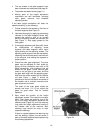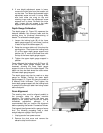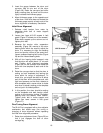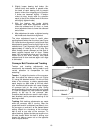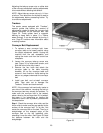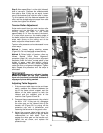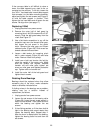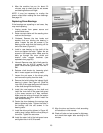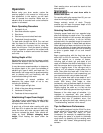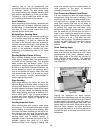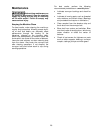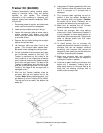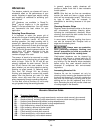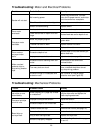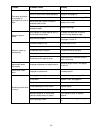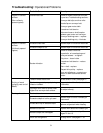
24
Operation
Before using your drum sander, review the
previous pages in this manual on initial set-up
and adjustment. In this section, you will learn
how to operate the machine. Make sure an
abrasive strip is mounted and a dust collection
system is connected.
Basic Operating Procedure
1. Set depth of cut.
2. Start dust collection system.
3. Start drum.
4. Start conveyor and select feed rate.
5. Feed stock through machine.
To feed stock through the 22-44 Pro, rest and
hold the board to be sanded on the conveyor
belt, allowing the conveyor belt to carry the
board into the drum. Once the stock is halfway
through, reposition yourself to the outfeed side
of the machine to receive and control the board
as it exits.
Setting Depth of Cut
Adjusting the drum sander for the proper contact
between the abrasive and the stock determines
the mechanical depth of cut.
It may take some experimentation to determine
the proper depth of cut, given the variables of
abrasive grit, type of wood, and feed rate. For
best results, use scrap wood to practice sanding
and to develop skill and familiarity with the
machine before doing finish work.
A combination of several variables will
determine the proper depth of cut to use,
including the following:
1. Abrasive type and grit size.
2. Width of the piece being processed.
3. Hardness of the piece.
4. Feed rate of the conveyor belt.
Establishing Proper Drum Height
The depth of cut is controlled by the table height
adjustment handle which raises or lowers the
conveyor table under the drum.
A good rule of thumb when sanding with grits
finer than 80 is to place the stock to be sanded
under the drum and raise conveyor table until
the drum contacts the stock. Drum should still
rotate by hand. Without changing drum
height, finish feeding the stock under the
sander.
Start sanding drum and sand the stock at that
same position.
Do not start drum while in
contact with stock!
For sanding with grits coarser than 80, you can
raise the conveyor table slightly.
Always maintain control of stock. Through
practice you will learn the proper depth of cut
considering the variables above.
Selecting Feed Rates
Selecting proper feed rate is an essential step
after first adjusting for depth of cut. The variable
feed rate controller of the conveyor belt adjusts
the load on the machine; it can be infinitely
adjusted within its specified range for maximum
operating performance. A faster feed rate allows
faster sanding but fewer revolutions of the drum
per inch of sanding. A slower feed rate provides
more revolutions of the drum per inch of sanding
to allow a greater depth of cut and smooth
sanding.
Begin experimenting with the feed rate set at
about 40% to 50% of maximum. The best feed
rate will depend on a number of factors,
including type of stock, grit and depth of cut
used, and whether the stock is fed directly in line
with the conveyor bed or at an angle. If the drum
motor is lugging down, if the conveyor belt is
slipping, or if you observe a ripple effect on the
stock, slow down the feed rate. If the finish is
smooth and the machine is not overworking, you
can experiment with using a faster feed rate.
Also try a faster feed rate or less depth of cut if
the stock you are working begins to show burn
marks. With cherry, hard maple or other
hardwoods, using a shallower depth of cut and a
faster feed rate will help minimize burn marks.
Slightly angling the stock as it is fed into the
machine will also help prevent burning the stock.
Because of the wide range of variables, it is
important to experiment with your specific
conditions and make adjustments to achieve the
optimum feed rate. If problems occur, first
check and adjust the feed rate, referring to the
“Troubleshooting” sections in this manual.
Tips for Maximum Performance
The versatility designed into the 22-44 Pro drum
sander allows it to be used for a wide variety of
tasks that will boost the return on your
investment. For example, its capabilities range
from taking the place of a planer to thickness
rough stock, to speeding up fine sanding work
often done with slower, dust-generating hand
sanders.



